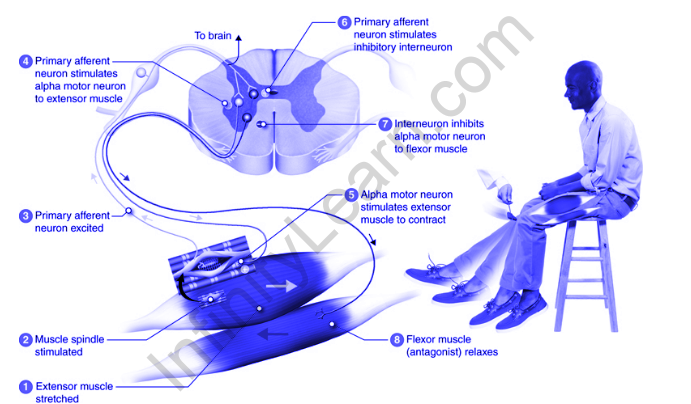
Courses

By Shailendra Singh
|
Updated on 24 Jan 2025, 18:41 IST
When there is an action there will be an immediate reaction in biology, the same thing applied but in different terms. Our body reacts to many actions – when we place our foot on a sharp object or hand on a heated object or another. When we encounter these types of incidents, we will give a response in seconds unknowingly.
So what do you do when things happen without your knowledge? How do we respond to it? What do we call this process? How does it work? Reflex action is the reason behind all this. It is an involuntary response to stimuli. When we encounter the incidents, as discussed above, we will give involuntary quick reflex actions to it. It is also known as a survival instinct. When we touch a hot pan in our absence of mind, we will react to it and quickly move our hands far from it. So, let’s learn more in detail about reflex action.

Reflex action is an involuntary action and instantaneous movement in response to a stimulus. A reflex that is made by a neural pathway is known as a reflex arc which acts on impulse before it reaches the brain. It is an automatic response to a stimulus that doesn’t need consciousness. We will call it an involuntary function when the brain’s permission is needed in doing it. Reflex is a Latin word, whose meaning is a reflection and was introduced by Marshall Hall in the 19th century.
The reflex arc is an anatomical pathway of a reflex. It has afferent or sensory nerves and efferent which is also known as motor nerves or secretory nerves or secretomotor nerves. Reflexes are having several synapses where stretch reflex is not having an interneuron in the arc and has only one synapse between efferent and afferent nerve fiber.
The parts of the reflex arc or the parts which help in this reflex action are described below.
The further reflex arc consists of the following parts:-
And there are some reflexes that we will observe in only infants. They are:
The Paper will definitely have a question or multiple questions from this area. They can ask about the reflex arc or the part of the reflex arc including their functions or nerves which are included in this process with their function. It’s an important chapter and you just need to understand the process and the functions of every part with some examples. You can score marks when you encounter questions related to this area or topic. If you want to get good marks easily then you should not avoid topics like these which give you marks easily by understanding the little things.
In this article, we have discussed reflex action which is involuntary action to stimuli, it process like how the ratio is going to come without involving the brain, the parts which are involved in this reflex action with their functions are also being discussed and we have also discussed the type of reflexes even there are some reflexes which occur in infants only. Some of them are sucking and swallowing reflexes; these are also known as first reflexes in humans. At last, we have discussed some examples of reflex action.

Reflex arc is an anatomical pathway of a reflex. It is having afferent or sensory nerves and efferent which is also known as motor nerves or secretory nerves or secretomotor nerves. Reflexes are having several synapses where stretch reflex is not having an interneuron in the arc and has only one synapse between efferent and afferent nerve fiber.
Reflex action is an involuntary action and instantaneous movement in response to a stimulus. A reflex that is made by a neural pathway is known as a reflex arc which acts on impulse before it reaches the brain. It is an automatic response to a stimulus that doesn't need consciousness. We will call it an involuntary function when the brain's permission is needed in doing it. Reflex is a Latin word reflex whose meaning is a reflection and was introduced by Marshall Hall in the 19th century.
The process of reflex action is mentioned below:
The parts of the reflex arc or the parts which help in this reflex action are described below.
The further reflex arc consists of the following parts: